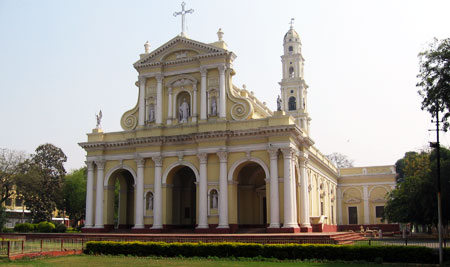THE ARCHDIOCESE AT A GLANCE
|
Archbishop
|
Most Rev. Raphy Manjaly (Jan. 2021 - present)
|
|
Primary Patroness
|
Immaculate Conception
|
|
Secondary Patron
|
St. Gonsalo Garcia
|
|
State
|
Uttar Pradesh
|
|
Area
|
49,162 Sq. Kms.
|
|
Total Population
|
31,800,000
|
|
Catholics
|
13, 665
|
|
Parishes/Mission Stations
|
48
|
|
Diocesan Priests
|
78
|
|
Priests of Changanacherry
|
21
|
|
Religious Priests
|
22
|
| Priests in the Regional
|
|
Institutions in Agra
|
10
|
|
Religious Brothers
|
08
|
|
Religious Sisters
|
356
|
|
Congregations (Men)
|
09
|
|
Congregations (Women)
|
37
|
|
Religious Houses (Men)
|
16
|
|
Religious Houses (Women)
|
77
|
|
Vianney Home for Priests
|
01
|
|
Educational Institutions
|
77
|
|
Hospitals
|
02
|
|
Dispensaries
|
04
|
|
Various Training Centres
|
13
|
|
Home for Destitutes/Dying
|
02
|
|
Hostels for Boys & Girls
|
05
|
|
Home for Children at Risk
|
04
|
|
Printing School / Press
|
01
|
|
Languages Spoken
|
Hindi, English & Urdu
|
A HISTORICAL PERSPECTIVE OF THE ARCHDIOCESE OF AGRA

Agra Archdiocese consists of the following districts in Uttar Pradesh: Agra, Aligarh, Auraiya, Budaun,
Bulandshahr, Etah, Etawah, Farrukhabad, Firozabad, Gautam Buddha Nagar, Hathras, Kannauj, Kasganj,
Mainpuri, Mathura and in Rajasthan, Bharatpur and Dholpur (17 Civil Districts).
Emperor Akbar wished to have some learned Christian priests in his Court, invited the Jesuits from
their college at Goa. The first 'Mughal Mission' was thus formed by Blessed Rudolf Aquaviva (later
a martyr at Goa), Antony Monserrate and Francis Henriques, who arrived at the Mughal Court, then
at Fatehpur Sikri in 1580. A second and then a third mission followed. Jesuits enjoyed the
patronage of Akbar and his son Jahangir, but under Shah Jehan and Aurangzeb this disappeared.
Though there was no Christian congregation of importance in Mughal India, there were a number
of individuals who wielded considerable influence in the Court and elsewhere.
When in 1773 the Jesuits were suppressed, two Carmelite Fathers from Bombay succeeded them in Agra,
who in turn, were replaced by the Capuchins after a very short while. By a decree of the Sacred
Congregation, dated May 17, 1784, the Vicariate-Apostolic of the Great Mughal was
constituted.
The history of the Agra Mission under the Capuchins is linked with their mission in Tibet. Early in
1708, four Capuchins started from Kathmandu reached Lhasa after two months. More Capuchins followed
them and took up their residence at Lhasa until April 20, 1745 when, owing to relentless persecution
by the Tibetan Priesthood they had to leave Tibet and return to Nepal. Thus the Capuchin Mission
in Lhasa came to an end. But the Mission continued its existence in Nepal until 1768.
The whole chain of Capuchin stations embracing the greater part of North India from Chandernagore to
Lhasa, from Sind to Bengal, from the Himalayas to Narmada river, now the dioceses of Ajmer, Jaipur,
Allahabad, Indore, Jhansi, Lahore, Lucknow, Meerut, Patna, Varanasi, Delhi, Jallandhar,
Simla-Chandigarh, Bijnor and Jammu & Kashmir (formerly Rawalpindi) all came to be known as
the Tibet Hindustan Mission. The Cathedrals at Agra, Ajmer, Allahabad, Delhi, Lahore (before
the new one), Madras, Patna and Simla are symbols and monuments of the untiring zeal of the
Capuchins for the extension of the faith and the progress of the Catholic Church in India.
The Prefecture Apostolic of Tibet -Hindustan was in 1820 constituted into the Vicariate Apostolic of
Agra with Msgr. Maria Zenobia Benucci, OFM Cap as its first Vicar Apostolic, who was succeeded by
Msgrs. Anthony Pezzoni and Anthony Borghi.
In 1845, the Agra Mission was divided into two separate vicariates: Agra and Patna. In 1846 the
Kingdom of Tibet was entrusted to the Society of the Foreign Missions. In 1861 the districts of
Allahabad, Oudh, Kanpur, Bundelkhand, Sagar and Bhopal were added to the Patna Vicariate, and
in 1880 the districts of Kumaon and Almorah. In the same year, the Vicariate Apostolic of the
Punjab was erected and separated from Agra. Finally in 1886 when the Catholic Hierarchy of
India was established, the Vicariate Apostolic of Agra became a Metropolitan See from which
the Prefecture Apostolic of Rajputana sprung in 1913, and in 1956, the nine northern districts
were formed into the Diocese of Meerut.
Thus, the Archdiocese of Agra is rightly called the Mother Diocese of all the Dioceses of North India.